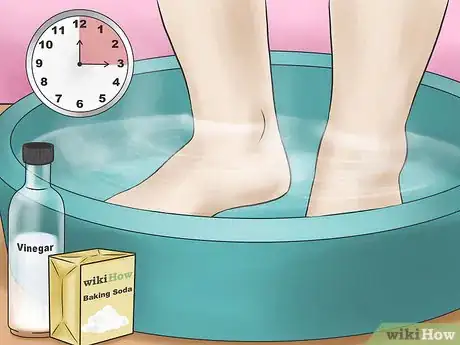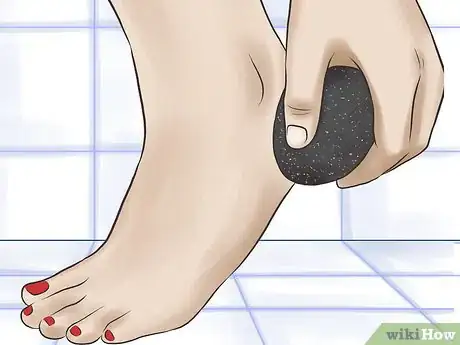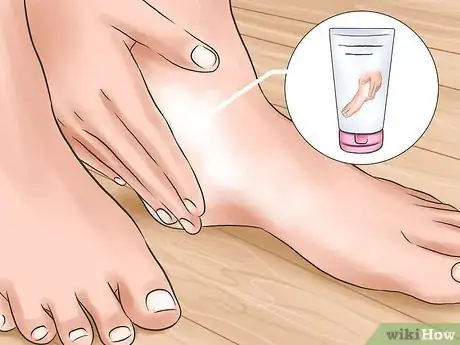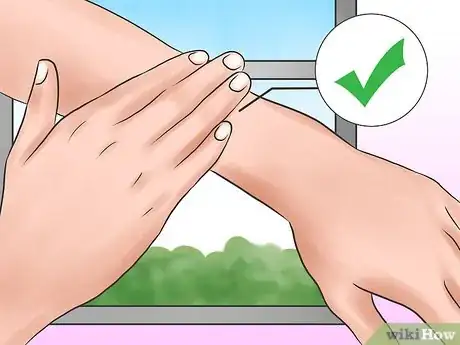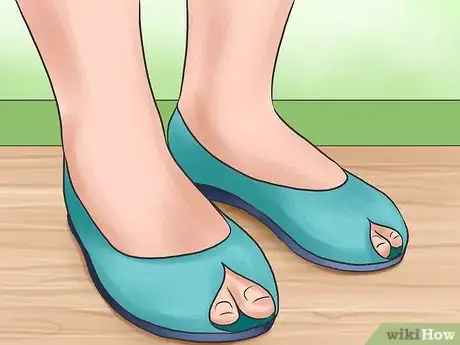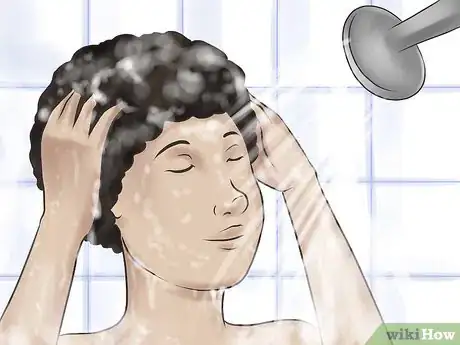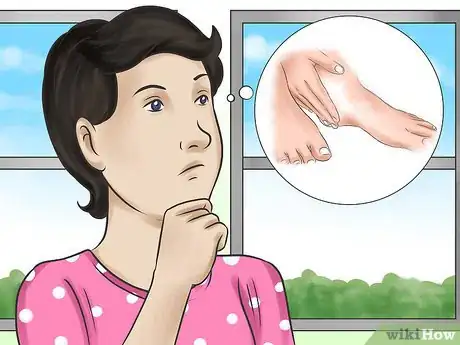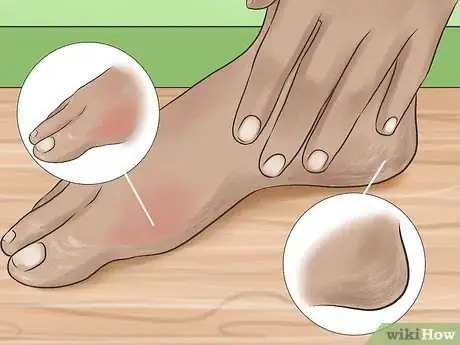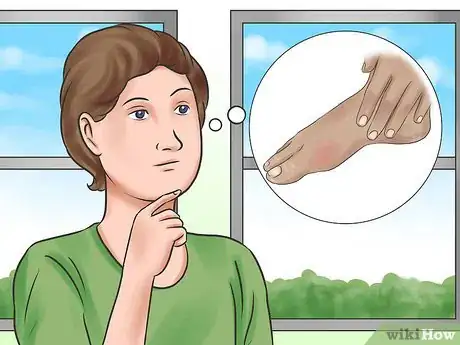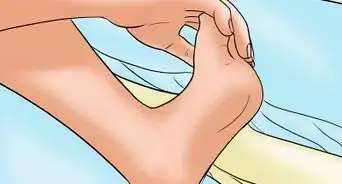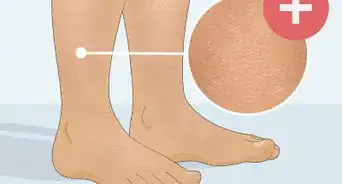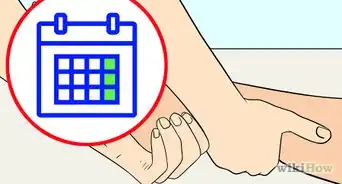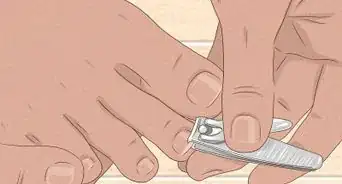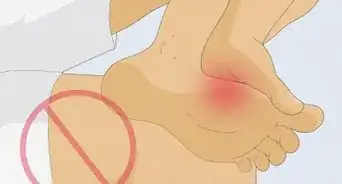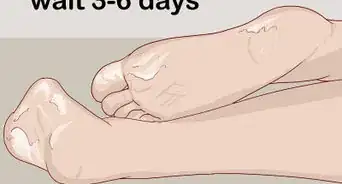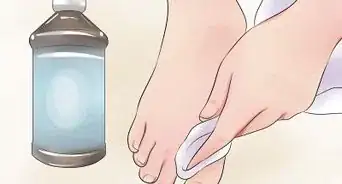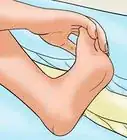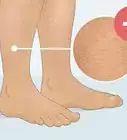This article was co-authored by Mark Co, DPM. Dr. Mark Co is a Podiatrist who runs his own private practice in San Francisco, California. Dr. Co specializes in treatments for bunions, ingrown toenails, toenail fungus, warts, plantar fasciitis and other causes of foot pain. He also offers custom orthotics for the treatment and prevention of foot and ankle issues. Dr. Co completed a Master of Business Administration (MBA) at New York University and an MA in Electrical Engineering and Computer Science at Johns Hopkins University. Dr. Co also completed his DPM at the California School of Podiatric Medicine and a residency and internship at the Kaiser Permanente Medical Center, Santa Clara, California. Dr. Co was awarded San Francisco's "Top 3 Podiatrists" in 2018, 2019, and 2020. Dr. Co is also a member of the CPMA (American Podiatric Medical Association).
There are 13 references cited in this article, which can be found at the bottom of the page.
wikiHow marks an article as reader-approved once it receives enough positive feedback. In this case, 100% of readers who voted found the article helpful, earning it our reader-approved status.
This article has been viewed 195,948 times.
Dry, rough skin on the feet can be more than just a cosmetic issue. Your foot is a complex musculoskeletal system that supports your whole body as you walk through life. Taking care of your feet can help reduce knee, hip and back pain as well as make your feet look great in sandals. There are a number of different treatments you can use to reduce dry and rough skin on your feet. If you don’t have success after several weeks you may need to see a physician who can evaluate your condition. In general, however, rough and dry skin which is not secondary to another health condition is often successfully treated at home.
Steps
Basic Care Tips
-
1Soak your feet. Although spending a long time in a chlorinated pool or hot bath is not good for the skin, soaking your feet for 15 minutes prior to moisturizing or exfoliating is helpful. Once your feet have healed and are no longer dry and rough, you won't have to soak them for treatment.
- Long soaks in a hot bath deplete the natural oils in the skin and the heat reduces the moisture in skin's outer layer, all of which contribute to dry skin, so limit the time you soak.
- Do not soak your feet more than three times per week or you’ll contribute to the drying skin instead of treating it.
- You can make different soaking mixtures, including:
- A mixture of baking soda and antifungal powder.[1]
- Mild soap (scented if you wish) with a bucket of warm water.
- 3 tbsp (75 g) of Epsom salt dissolved in 1⁄2 US gal (1.9 L) of water.[2]
- A quarter cup of white vinegar in a bucket of warm water.
- A quarter cup of lemon juice that will dissolve dead and dry skin.[3]
-
2Exfoliate. Mechanical exfoliation means removing the dead top layer of skin in order to treat the underlying layers. You can use a pumice stone, stiff brush, or loofah after softening the top layers of skin through soaking.[4]
- A pumice stone is found at a pharmacy or in the pharmacy department of a large store. These are great for removing thick skin from the bottoms and heels of your feet.[5]
- You don’t need a specific type of stiff brush. Even a brush from the household cleaning department works as long as you don’t use it for anything else.
- It's a good idea to soak your feet in warm water or take a warm shower for 10–15 minutes before exfoliating.
Advertisement -
3Moisturize. Once you have removed the outer layer of dead cells it’s time to add moisture back to the skin. Moisturize immediately after a shower or soaking using a non-alcohol based product to trap the moisture that is on the skin and keep the skin moist. Some moisturizers work to seal in the moisture on your skin and others work by penetrating the skin to the dermal layer. Either way, since the skin on your feet is thicker than the skin on the rest of the body, opt for a thick cream to ensure it can penetrate deep into the skin.[6]
- Thick creams like Eucerin and Cetaphil work to trap the moisture in the skin. Other products with lanolin work in the same way. Olive oil has the same effect on the skin and is likely in your kitchen cabinet. Use just a little, rubbing it and massaging it into the skin.
- Other moisturizers will be absorbed into the skin and work at the dermal layer. Coconut oil is an oil that has many beneficial properties, including being naturally antibacterial and antifungal. Used on your feet it will moisturize the skin, improve healing of any cracked areas, and help prevent infections.[7] [8]
- Alcohol-based products may be less “greasy” feeling, but the alcohol will also dry the skin out faster.
- After moisturizing your feet put on a pair of cotton socks to reduce the potential for slipping and falling on the floor and to keep the moisturizer on your feet.
-
4See your doctor. If these remedies are not successful after repeated use, you may need to see your doctor. Expect to be tested for hypothyroidism if the dry skin extends to your arms and legs as well.[9]
- If your dry skin is resistant to the measures you have taken at home, your doctor may recommend an over-the-counter product that contains lactic acid or lactic acid and urea. These ingredients help the skin to hold more moisture.
- A more serious condition might require prescription ointments or creams to reduce the potential that the skin will crack due to dryness.
Lifestyle Changes
-
1Stay hydrated. Your skin uses the moisture in your body to stay hydrated and nourished. When you get dehydrated, the water in your body is used for the highest priority functions, like blood flow, before it is used in the skin. By drinking at least eight 8 oz glasses of water per day, the skin all over your body will stay hydrated and not dry out quickly.
- Try to avoid alcohol and caffeine whenever possible as these can heighten the itchiness of dry feet.[10]
-
2Watch the side effects of any medications you are taking. Diuretics used to decrease the amount of water in the body or topical or oral retinoids used to treat acne can cause temporary dry skin.[11]
- If the side effect of dry skin is present for more than two weeks, discuss a potential medication change with your physician.
-
3Wear cotton socks. Cotton socks allow your feet to breathe and dry off if you’re sweating. Keeping sweat against your skin will increase the rate at which moisture leaves the skin and your feet dry out.
- Change your socks daily or after sweating (e.g., from a workout or a long walk). Wash them well after each use.
- Sleep in socks after you moisturize your feet each night.
-
4Wear shoes that allow your feet to breathe. Avoid wearing the same pair of shoes day in and day out. Your feet need to breathe in order to retain moisture so try to wear supportive sandals during the summer or other shoes with air pockets. During the winter, avoid wearing your heavy winter boots indoors at work or school and instead bring another pair of lighter and more breathable shoes to change into.
- To ensure your feet stay healthy, make sure to wear shoes with proper arch support.[12]
-
5Avoid harsh, drying soaps. Harsh soaps do not get you any cleaner than one that is gentle to your skin. However, they do dry out your skin and leave you prone to dry skin. Harsh soaps deplete the fats in your skin, which leaves your skin feeling tight and dry.[13] [14]
- Dermatologists often recommend soaps with a high glycerin content, such as pure glycerin bar soaps and naturally made bar soaps. You can find these at most drug stores and all natural health stores.[15]
-
6Use warm water in the shower or bath. Instead of a having a hot shower or bath, keep the water at a warm temperature and limit your time to less than 10 minutes in the water. Hot water and low humidity in the air reduce the water in the outer layer of in the skin, which results in skin that feels tight and dry.[16]
- A good rule of thumb is to set your water temperature in the shower/bath to one that feels comfortable but that doesn't make your skin red.
More Information
-
1Know the functions of your skin. Your skin, your body's largest organ, is tough and stretches. It has the job of protecting your body from bacteria, viruses, and fungi. When there are cracks and breaks in the skin, this allows infectious agents to access your blood supply. In addition, your skin functions in thermoregulation, or keeping your body temperature at an optimal temperature for functioning.[17]
- Your skin is sensitive which allows you to feel different types of sensations which are interpreted by the brain. There are no areas of the body that are normally numb, or without feeling, including your feet.
- New skin cells are made each day. Your body gets rid of between 30,000 and 40,000 skin cells from all over the body every minute of every day.[18] The dead skin cells are on the top 18 to 23 layers of skin.
- Your outer layer of skin which consists of dead skin cells is called the epidermis. This area of the skin is very thin in some areas of the body — such as the eyelids — and thicker in others — such as the bottom of your feet. When the old skin cells in the epidermis fall off, new cells are underneath.
-
2Diagnose dry and rough feet. Dry skin is called xerosis. It will appear lighter in color than the rest of the foot and will often feel rough to the touch. You might experience:[19]
- Itchiness
- Cracked skin
- Redness
- Fissures (deep cracks) in the heel of the foot
- Peeling skin
- Both the heel and ball of the foot where most of the contact with the ground is made, are at higher risk of becoming rough. This increases the risk of cracking and peeling skin.
-
3Understand the causes of dry feet. The skin on the bottom of your feet can become dry and rough for a number of different reasons, including:
- Age: Age and hormonal imbalances caused by aging (due to processes like menopause) cause your skin to lose elasticity and lipids, which increases the risk of dry skin.
- Climate: Living in a dry climate can reduce the amount of moisture in the skin and result in dry skin. In addition, air conditioning removes humidity from the air, reducing the natural moisture in the skin. Winter weather is also damaging to the skin.
- Skin conditions: Atopic dermatitis and psoriasis are two skin conditions which can develop dry and rough patches where they affect the skin.
- Chlorine: Swimming or soaking in highly chlorinated pools can reduce the natural moisture in your skin.
- Medical conditions: People who have diabetes often suffer from dry skin on their feet, which increases their risk of infections. Poor blood supply can lead to reduced moisture to the skin cells and increase the risk of complications.[20] If you have diabetes and dry feet, visit a doctor or podiatrist for your foot care needs.
-
4Prevent dry and rough feet. Prevention is always the best medicine. It is easier to keep your feet well cared for than to reverse the effects of dry and rough skin. Here are some tips for maintaining healthy and soft feet:[21]
- As you age, take good care of your feet, using the treatments mentioned above.
- If you swim consistently in a chlorinated pool, take extra precautions to care for the skin over your feet. Chlorine will remove moisture from your skin and result in dry skin.[22]
- Shower and bathe only as long as necessary to get clean but not longer. Opt for showers over baths to decrease the risk of reducing the natural moisture in your skin. Always moisturize (with a non-alcoholic moisturizer) after each bath or shower.
- If you suffer from atopic dermatitis or psoriasis, take special care of the skin on your feet to reduce the potential for cracked and peeling skin.
- If you have diabetes, evaluate your feet every night for breaks in the skin. You can reduce the risk of developing complications related to your diabetes if you practice prevention and care for your feet.
Expert Q&A
Did you know you can get expert answers for this article?
Unlock expert answers by supporting wikiHow
-
QuestionWhat causes blisters on dry, cracked feet?
 Catherine Cheung, DPMDr. Catherine Cheung is a board certified Podiatrist based in San Francisco, California. Dr. Cheung specializes in all aspects of foot and ankle care, including complex reconstruction. Dr. Cheung is affiliated with the Brown & Toland Physicians and the Sutter Medical Network. She earned a DPM from the California College of Podiatric Medicine, completed her residency at the Encino Tarzana Medical Center, and completed a fellowship at the Kaiser Permanente San Francisco Medical Center. She is board certified by the American Board of Podiatric Surgery.
Catherine Cheung, DPMDr. Catherine Cheung is a board certified Podiatrist based in San Francisco, California. Dr. Cheung specializes in all aspects of foot and ankle care, including complex reconstruction. Dr. Cheung is affiliated with the Brown & Toland Physicians and the Sutter Medical Network. She earned a DPM from the California College of Podiatric Medicine, completed her residency at the Encino Tarzana Medical Center, and completed a fellowship at the Kaiser Permanente San Francisco Medical Center. She is board certified by the American Board of Podiatric Surgery.
Board Certified Podiatrist Blisters normally form from some sort of abnormal motion when you're walking. It could be how your foot rubs against a shoe or it may be the way you're walking. Identify what's causing the blister to form and change your shoes or walking motion. If the blister is just irritated skin, leave it alone and it will eventually dry out fine. You may have to put some sort of bandage on it just to protect it from being painful. If the area has fluid in it, that's when it gets a little bit more tricky. You'd have to make sure it's very clean and wash the area. You may actually have to drain it a little bit if it's a big area with fluid and you might have to do that with a sterilized needle, just to get the fluid out. Then, bandage the area and let it dry out on its own.
Blisters normally form from some sort of abnormal motion when you're walking. It could be how your foot rubs against a shoe or it may be the way you're walking. Identify what's causing the blister to form and change your shoes or walking motion. If the blister is just irritated skin, leave it alone and it will eventually dry out fine. You may have to put some sort of bandage on it just to protect it from being painful. If the area has fluid in it, that's when it gets a little bit more tricky. You'd have to make sure it's very clean and wash the area. You may actually have to drain it a little bit if it's a big area with fluid and you might have to do that with a sterilized needle, just to get the fluid out. Then, bandage the area and let it dry out on its own. -
QuestionDoes wearing socks help dry feet?
 Mark Co, DPMDr. Mark Co is a Podiatrist who runs his own private practice in San Francisco, California. Dr. Co specializes in treatments for bunions, ingrown toenails, toenail fungus, warts, plantar fasciitis and other causes of foot pain. He also offers custom orthotics for the treatment and prevention of foot and ankle issues. Dr. Co completed a Master of Business Administration (MBA) at New York University and an MA in Electrical Engineering and Computer Science at Johns Hopkins University. Dr. Co also completed his DPM at the California School of Podiatric Medicine and a residency and internship at the Kaiser Permanente Medical Center, Santa Clara, California. Dr. Co was awarded San Francisco's "Top 3 Podiatrists" in 2018, 2019, and 2020. Dr. Co is also a member of the CPMA (American Podiatric Medical Association).
Mark Co, DPMDr. Mark Co is a Podiatrist who runs his own private practice in San Francisco, California. Dr. Co specializes in treatments for bunions, ingrown toenails, toenail fungus, warts, plantar fasciitis and other causes of foot pain. He also offers custom orthotics for the treatment and prevention of foot and ankle issues. Dr. Co completed a Master of Business Administration (MBA) at New York University and an MA in Electrical Engineering and Computer Science at Johns Hopkins University. Dr. Co also completed his DPM at the California School of Podiatric Medicine and a residency and internship at the Kaiser Permanente Medical Center, Santa Clara, California. Dr. Co was awarded San Francisco's "Top 3 Podiatrists" in 2018, 2019, and 2020. Dr. Co is also a member of the CPMA (American Podiatric Medical Association).
Podiatrist
-
QuestionCan I use baby petroleum jelly to moisturize my heels?
 Chris M. Matsko, MDDr. Chris M. Matsko is a retired physician based in Pittsburgh, Pennsylvania. With over 25 years of medical research experience, Dr. Matsko was awarded the Pittsburgh Cornell University Leadership Award for Excellence. He holds a BS in Nutritional Science from Cornell University and an MD from the Temple University School of Medicine in 2007. Dr. Matsko earned a Research Writing Certification from the American Medical Writers Association (AMWA) in 2016 and a Medical Writing & Editing Certification from the University of Chicago in 2017.
Chris M. Matsko, MDDr. Chris M. Matsko is a retired physician based in Pittsburgh, Pennsylvania. With over 25 years of medical research experience, Dr. Matsko was awarded the Pittsburgh Cornell University Leadership Award for Excellence. He holds a BS in Nutritional Science from Cornell University and an MD from the Temple University School of Medicine in 2007. Dr. Matsko earned a Research Writing Certification from the American Medical Writers Association (AMWA) in 2016 and a Medical Writing & Editing Certification from the University of Chicago in 2017.
Family Medicine Physician
Warnings
- If you are diabetic it is vital that you care for your feet. Diabetes reduces the efficiency of blood circulation in the feet. This means that just a small crack in the skin or small cut can result in an infection which won’t heal easily.⧼thumbs_response⧽
References
- ↑ Catherine Cheung, DPM. Board Certified Podiatrist. Expert Interview. 21 April 2019.
- ↑ Mark Co, DPM. Podiatrist. Expert Interview. 21 April 2020.
- ↑ http://www.footvitals.com/skin/dry-feet.html
- ↑ http://www.drbaileyskincare.com/blog/dermatologist%E2%80%99s-3-simple-steps-for-soft-sandal-ready-feet-by-spring/
- ↑ Mark Co, DPM. Podiatrist. Expert Interview. 21 April 2020.
- ↑ Mark Co, DPM. Podiatrist. Expert Interview. 21 April 2020.
- ↑ http://www.ncbi.nlm.nih.gov/pubmed/15724344
- ↑ http://www.americanskin.org/resource/dryskin.php
- ↑ http://www.mayoclinic.org/diseases-conditions/dry-skin/basics/tests-diagnosis/con-20030009
- ↑ http://www.footvitals.com/skin/dry-feet.html
- ↑ http://www.americanskin.org/resource/dryskin.php
- ↑ Mark Co, DPM. Podiatrist. Expert Interview. 21 April 2020.
- ↑ http://www.americanskin.org/resource/dryskin.php
- ↑ http://www.footvitals.com/skin/dry-feet.html
- ↑ http://www.drbaileyskincare.com/blog/dermatologist-explains-what-causes-dry-skin/
- ↑ http://www.americanskin.org/resource/dryskin.php
- ↑ http://www.merckmanuals.com/home/skin-disorders/biology-of-the-skin/structure-and-function-of-the-skin
- ↑ http://m.kidshealth.org/kid/htbw/skin.html
- ↑ http://www.footvitals.com/skin/dry-feet.html
- ↑ http://www.diabetes.org/living-with-diabetes/complications/foot-complications/?referrer=https://www.google.com/
- ↑ http://www.americanskin.org/resource/dryskin.php
- ↑ http://healthyliving.azcentral.com/effects-swimming-swimmers-hair-skin-3800.html
About This Article
To care for rough, dry feet, start by soaking your feet for 15 minutes in a tub of warm water mixed with 1/2 cup of Epsom salt. Next, exfoliate the rough areas of your feet with a pumice stone or stiff brush to remove the dead skin. Then, moisturize your feet with olive or coconut oil and put on a pair of cotton socks to lock in the moisture. Additionally, make sure to drink at least 8 glasses of water a day so that your skin will stay hydrated and not dry out as quickly. For more tips from our Medical co-author, like how to identify the cause of your dry feet, read on!
